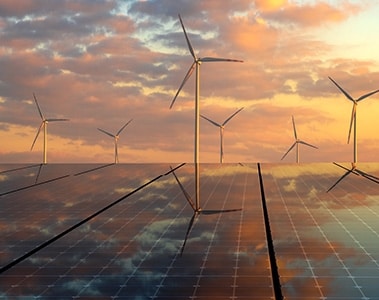
Enabling a low-carbon economy
DSM enables a low-carbon economy through everything from sustainable materials and resins, to new farming methods, to renewable energy innovations.
To be a leader in climate action it’s important to lead by example. That’s why at DSM we closely manage our absolute Greenhouse Gas (GHG) emission reduction; GHG efficiency; and energy efficiency.
In 2018 we targeted a 30% absolute reduction of the company’s direct GHG emissions (Scope 1) and emissions from our purchased energy (Scope 2) by 2030*. In 2021?we raised the bar further?by aiming for a 50% absolute reduction by 2030*, and in 2022 went further still by targeting a 59% absolute reduction by 2030*.
In addition, DSM aims to reduce its indirect value chain emissions (Scope 3) by 28% per ton of product produced in the same period. These targets have been validated by the?Science Based Targets initiative (SBTi)?to be in line with the latest climate science and in limiting global warming to 1.5°C.
DSM has also set a long-term target to reach net-zero GHG emissions across our value chain by 2050. Ultimately, together with our partners, we are committed to?eliminating our carbon footprint for the next generation. This means that we are aiming to structurally decrease emissions as close to zero GHG emissions as possible, a 90% reduction at a minimum by 2050 if not sooner. In the long-term, we will also neutralize any residual emissions through permanent carbon removals meeting the highest quality criteria and social and environmental safeguards. DSM is also exploring investing in the?highest impact climate mitigation activities beyond our value chain to accelerate a global net-zero transition.
Furthermore, as an essential complement to our efforts to cut emissions, we also apply an integrated strategy of climate adaptation measures. For example, to improve the resilience of our assets and supply chains against potential physical impacts of climate change, we are developing our physical risk assessment. This involves mapping high-risk areas and major sites for emerging hazards and long-term impacts using different time horizons and climate scenarios.
We report on our climate actions through CDP (formerly the Carbon Disclosure Project), and we’ve committed to reporting this information in mainstream reports as part of our fiduciary duty implementing the recommendations of the Task Force on Climate-related Financial Disclosures (TCFD).
*) from 2016 as baseline year
| ? | Aspiration | 2022 | 2021 | 2020 | 2019 |
|---|---|---|---|---|---|
| Greenhouse gas (GHG) | ? | ? | ? | ? | ? |
| GHG emissions scope 1 + 2 absolute reduction versus 2016 | 59% in 2030 | 35% | 27% | 25% | 25% |
| GHG emissions scope 3 intensity reduction | 28% by 2030 | 17% | 8% | 5% | - |
| Energy | ? | ? | ? | ? | ? |
| Purchased electricity from renewable sources | 100% by 2030 | 78% | 72% | 60% | 50% |
How we are achieving our targets? Well we ensure that all new investments by our businesses are carbon neutral, and have dedicated investment programs on renewable energy and energy efficiency, we set-up in the light of adopting an Internal Carbon Price?for example.
In 2018 we concluded a new €1 billion Revolving Credit Facility with our long term banking partners that links the interest rate payable to our GHG emission reductions., underscoring the importance of sustainability in everything we do - including corporate finance.
Furthermore, as our suppliers play a key role in delivering our strategy and targets, we are working closely with them on emission reduction projects through our CO2REDUCE program.
In line with Sustainable Development Goal 7 (affordable and clean energy for all) we’re committed to responsible, efficient use of energy. At DSM we depend on the availability of renewable electricity via the grid or local electricity production. As local policies affect our ability to scale-up our procurement of renewable electricity, we work closely with authorities and other companies to scale-up supply of renewable electricity on the grid, including our own on-site solar fields at several sites.
We’re also a signatory of the Climate Group’s?Renewable Energy 100 (RE100) initiative, which brings together the world’s leading companies committed to sourcing 100% of their electricity from renewable sources at the earliest possible opportunity.?The intermediate target we set for 2030 is for 100% of our purchased electricity to be obtained from renewable sources.
In 2022, we once again made significant steps toward achieving our?purchased renewable electricity target aiming to be at 100% by 2030. The percentage of purchased electricity from renewable sources increased globally from 72% in 2021 to 78% in 2022, achieving our previous target eight years ahead of schedule and putting us firmly on track toward our new target level. The progress in renewable electricity is mainly due to a step-up in China, where we concluded several?renewable electricity contracts?increasing the share of electricity from renewable sources to 32% from 16% in 2021. This includes the sites Jiangyin, Jiangshan, Yantai, Yimante and Wuxi.
For our operations in Europe, US and Canada, we maintained?100% renewable electricity?through existing agreements combined with pre-production guarantees of origin (GOs) and production of electricity from a Power Purchase Agreement?(PPA).
We also continue to make progress to?reduce the use of fossil fuels?in the production of steam and heat using low-carbon and biomass heat sources and the search for low-carbon heat solutions is becoming more prominent in our?GHG?reduction program: we are working to optimize the use of waste streams and are actively screening the market for opportunities to collaborate with external partners.
To encourage investments in low-carbon and carbon-free technologies, we use an internal carbon price in the valuations of key investment projects and in the Profit and Loss statements of the business groups for internal management reporting. ??Since 2019, business growth projects must either be GHG-neutral or else be compensated for within the same business. This increases the visibility of, and encourages accountability for, the impact of carbon on the business. In 2021, we increased the ICP from €50/t CO2eq to €100/t CO2eq to better reflect the updated insights on the actual price of CO2 to society. This price is also within the ranges of the scenarios we use for assessing climate transition risks.

DSM enables a low-carbon economy through everything from sustainable materials and resins, to new farming methods, to renewable energy innovations.

Together with our value chain partners, we are committed to eliminating our carbon footprint for the next generation.

DSM puts great effort into managing sustainability and putting the right people, partners and processes in place.